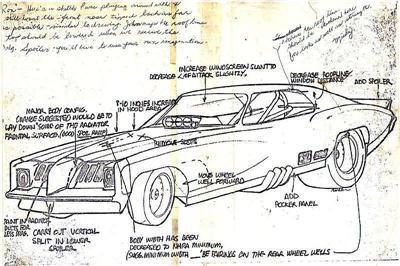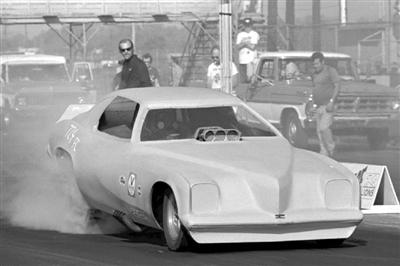

Mickey Thompson's Grand Am, Part 1
 |
We all have favorites in our lives. Favorite song, favorite band, favorite movie, favorite actor, favorite color, etc., etc., but for drag race nuts like us, none of them holds a candle to memories of our favorite race car. Today, we're going to talk about one of mine: the Mickey Thompson Grand Am Funny Car.
Although the Grand Am didn’t even crack the top 16 from my reader-wide Favorite Race Car Ever vote of mid-2008, it still remains forever ingrained in my heart for its sleek look and outside-the-box thinking. In a period when it seemed that every other Funny Car was a Vega or a Monza or a Mustang, M/T's Pontiac stood out from the crowd. It ran well, too, setting various low e.t.s and, under Dale Pulde's command, the national record. The car has a bit of a checkered past, too, as it burned a few of its drivers not only with fire but also financially, giving it that "bad boy" mystique as well. So, what’s not to like, right?
If you’re an NHRA Member who visits the new NationalDragster.net website, you saw that I featured the car last week in the My Favorite Fuelers column I write there each Friday, but that article was certainly not the definitive piece I’ve been promising longtime readers of this column. Nope – that’s what you guys are getting today. It’s going to be in two pieces, covering the conception and initial season this week and the later years next week.

As longtime drag fans well know, Thompson had a long history with Pontiac dating back to his Bonneville land-speed record runs in the late 1950s and his early dragsters, including the 1962 Indy-winning machine driven by Jack Chrisman. But Thompson’s early Funny Cars were Fords (Mustangs and Pintos), so when the production Grand Am was announced in 1972, it’s not clear whether he chose Pontiac or Pontiac chose him to create the new body. What we do know is that he chose Ron Pellegrini’s Chicago-based Fiberglass Ltd. shop (see my 2010 column: The Johnny Appleseed of the Fiberglass Forest) to create the body.
“We picked up a Grand Am from Pontiac three months before they came out,” Pellegrini recalled, “and we had one section in our shop that was blocked off and had restricted access because we would get cars from Ford and Chevrolet and Pontiac. We did some drawings of what we thought the body might look like that I sent out to Mickey, and he made some more changes to it.”

John Buttera built the 118-inch chassis, and Pulde and crew chief Steve Montrelli thrashed the car together in time to debut it (albeit in primer) at the Last Drag Race at Lions DragStrip in early December and lost in round one to Don Prudhomme.
“It was the first Buttera car over 115 inches,” Pulde noted. “Montrelli and I had been running the Pinto. We had been watching all of the guys hang weight on the front end of their cars and decided we could either move the motor out or make the wheelbase longer so it wouldn’t do it. Buttera fought with us, but we ended up doing that.”
Pulde was eager for the 1973 campaign, but Montrelli was wooed away by Don Schumacher to tune on his Funny Cars (including, eventually, the famed Wonder Wagon). If it wasn’t painful enough for Pulde that he lost his wingman, Thompson stunned everyone by hiring Butch Maas to drive the Grand Am for 1973.

The Revelleader made its official debut at the 1973 Winternationals, where it was the low qualifier but lost in round one. (Below) From left, Mickey Thompson, crew chief Mike Broome, and driver Butch Maas.
|
 |
“I’m not sure exactly what happened, but he didn’t think I would take the car and run it on my own, so he hired Butch to finish the car,” said Pulde. “I think it was a miscommunication. Montrelli was shocked when Mickey told him what he had done and called Mickey and asked him why he didn’t give me the chance, and he told him he just didn’t think I'd want to, and Butch was here.”
Thompson also acquired sponsorship from model giant Revell (which sponsored a ton of Funny Car teams at the time), and the newly named Revelleader Grand Am -- painted yellow with a white swoosh stripe -- debuted in spectacular fashion at the Winternationals by qualifying No. 1 with a 7.18, more than a tenth and a half ahead of No. 2 qualifier Tom Hoover's 7.35. Maas lost in the first round in Pomona when the car lost fire against Kenny Bernstein.
Maas sadly is no longer with us to tell his side of the story, but I did get to speak to Mike Broome, who worked with Maas on the car. Broome had owned Top Fuel cars in the early 1970s and later went to work with Jerry Ruth on his Funny Cars (and was part of Ruth’s Top Fuel crew during his 1972 Indy runner-up). He met Maas at the 1972 NHRA World Finals in Amarillo, Texas, and later was hired to work on the Revelleader.
“When we qualified No. 1 at Pomona, that was the year of the greasy track, but we were loaded for bear [Sunday] with two complete motors and a short block,” he recalled. “Butch lost fire on the burnout, and that ended that. Next we raced in Fremont and lost in the final. We went back to L.A. and packed up to head to Gainesville.”

Steve Reyes' photos tell the story of the end of the first Grand Am in a qualifying fire at the 1973 Gatornationals that forced Maas from the cockpit.
|
 |

The going wasn't always easy (Tom Derry photo)
|
It was in Gainesville during qualifying for the Gatornationals that Maas endured a terrible fire and was badly burned, putting him on the sidelines.
Broome recalled, “During the first day of qualifying, there were rain showers in the area, and the forecast was for rain the next day, so Butch wanted to make the first run a good one. The car made a nice run but burned some pistons and caught fire in the lights. By the time I got to the end of the track, they had Butch out of the car, and I rode with him to the hospital. Ed McCulloch looked after loading the remains of the car, and I stayed with him until he left. After a few days seeing Butch at the hospital and knowing he was going to be all right, Mickey thought I should bring what was left back to L.A. and see what could be salvaged.
“I drove straight back to L.A., stopping only for gas; I think I slept for a full day and then had the remains of the car checked out at Buttera’s, and it was decided to build a whole new car. I think it only took a month to put together the new car. We had a lot of help from a lot of people to get it done; I can’t thank enough Mickey’s sister Colleen, husband Gary, and daughter Shelly for making me feel like part of the family and looking after me while I was in L.A. and keeping in touch when on the road. For a young guy, it was pretty special.”
Thompson not only hired Pulde back to oversee the rebuild, but he also offered him back the seat and chance to run the car on his own. Once it was completed, Pulde and Broome headed out on to the match race tour but [damaged the body] on their first run in St. Louis. They stayed up all night to fix the body, then won the race the next day.
“It all went pretty well the first few months,” recalled Broome. “In late July, I had a chance to go to work with Billy Meyer running his SMI Motivator Mustang, which I did until the end of the season.”
Pulde finished out the season with the car and, during the winter, helped build a lighter and sleeker ’74 car, taking the hard lessons learned in 1973 and incorporating design changes that ultimately turned the car and Pulde into national record holders, but that came long after Pulde had soured on continuing his partnership with Thompson.
Related columns:
Mickey Thompson's Grand Am, Part 2
A Grand (Am) photo gallery
Some sweet photos of Mickey's machines



















































